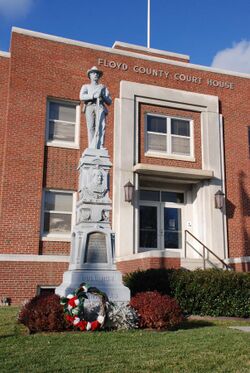Chemistry:White bronze
White bronze is a white-coloured alloy. Examples of various alloys composed of copper, tin and zinc or composed of zinc, copper, aluminum and magnesium.[1][2] A modern composition contains 55% copper, 30% tin and 15% zinc.[3] A 1904 patent for "white bronze" is composed of 86% zinc, 9.9% copper, 4% aluminum and 0.1% magnesium.[1]
History
Use in monuments
In the United States, starting in the 1870s, white bronze was a material used in monuments, particularly gravestones. White bronze gravestones are most common in East Coast cemeteries, but can be found throughout the country.[4] White bronze was also commonly used in Civil War memorials. White bronze monuments could be mass produced, providing a more affordable alternative to more traditional materials like bronze, marble, and granite. Northern manufacturers, like the Monumental Bronze Company in Bridgeport, Connecticut, and the National Fine Art Foundry in New York City , often produced both Union monuments for Northern communities and Confederate monuments for Southern communities.[5] Southern communities tended to be less forthcoming about the Northern origins of the statues. The monuments in the different parts of the country were often very similarly designed, only minuscule details such as the letters on belt buckles, differentiating them. The durability and longevity of the monuments made from this material was advertised by manufacturers, however they were particularly weak around the seams.[citation needed] The demand for white bronze monuments declined after World War I.[6]
References
- ↑ 1.0 1.1 Christopher H. Bierbaum: Alloy. US-Patent No. US778398.
- ↑ "Miralloy White Bronze Plating". https://arlingtonplating.com/capabilities/white-bronze-plating/. Retrieved 28 March 2020.
- ↑ "White Bronze, Copper-Tin-Zinc Tri-metal: Expanding Applications and New Developments in a Changing Landscape". https://www.pfonline.com/articles/white-bronze-copper-tin-zinc-tri-metal-expanding-applications-and-new-developments-in-a-changing-landscape.
- ↑ Broman, Elizabeth (April 14, 2014). "White Bronze - Designing for Death". https://www.cooperhewitt.org/2014/04/14/white-bronze-designing-for-death/.
- ↑ Arellano-Fryer, Lola (June 15, 2017). "The North's Role in Supplying the South with Confederate Monuments". https://hyperallergic.com/384776/the-norths-role-in-supplying-the-south-with-confederate-monuments/.
- ↑ Fisher, Marc (August 18, 2017). "Why those Confederate soldier statues look a lot like their Union counterparts". https://www.washingtonpost.com/politics/why-those-confederate-soldier-statues-look-a-lot-like-their-union-counterparts/2017/08/18/cefcc1bc-8394-11e7-ab27-1a21a8e006ab_story.html.
 |


